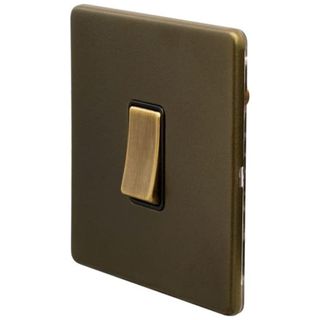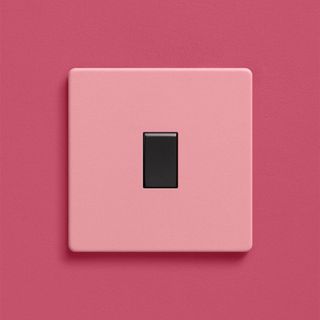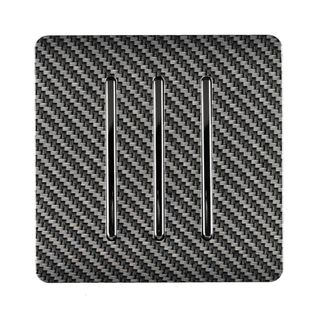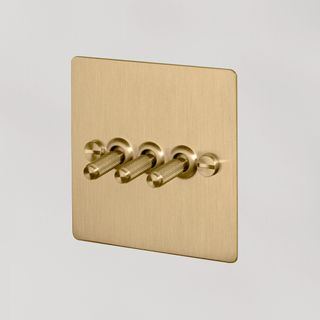Understanding types of light switches and how to choose them
We take a look at different types of light switches and determine how to pick the right one for your home lighting scheme

When renovating your home, light switches might seem like a small detail, but they can have a significant impact on how you experience and interact with your space.
From the basic one-way switch to more advanced two-way and intermediate options, understanding how the different types of light switches function is essential to perfecting your lighting design. With the growing popularity of dimmer switches and smart lighting, there are now even more ways to personalise the ambience and control of your home’s lighting. But how do you know which option is right for you?
In this guide, we’ll break down the different types of light switches, decode terms like 'one-gang' and 'two-way,' and offer practical advice for planning your lighting circuits.
One-way, two-way & intermediate
Have you ever come across the terms 'one-way', 'two-way', or 'intermediate switches' and wondered what they actually mean? These terms refer to the different types of light switches, each designed to suit specific lighting control needs in your home.
One-way switches
A one-way switch is the most basic type of light switch, controlling a light fixture from a single location. This is the standard switch used in most rooms where the light is only turned on or off from one spot, such as a bedroom, bathroom, or closet lighting.
One-way switches are the easiest type of light switch to install and use, making them the default choice for many basic lighting setups. Generally, they are also the most affordable type of switch, which also makes them suitable for smaller budgets.
That being said, because you can only control the light from one location, one-way light switches can be inconvenient in larger or more complex spaces. So, when you are considering one-way switches it’s important to think carefully about the switch placement. Ensure that it’s easily accessible when entering or leaving the room so you aren't feeling around in the dark.
Two-way switches
"Two-way switching, as the name suggests, controls a circuit from two locations,'" explains Alex Steele, Technical Engineer at John Cullen Lighting. "This setup is particularly useful in spaces with multiple entry points, such as hallways, staircases, or large rooms, where controlling the light from different locations is convenient."
Installing two-way switches requires more complex wiring compared to one-way switches, which can make the installation slightly more expensive and time-consuming. If you don't have any experience wiring a light switch, consider hiring an electrician for this task.
When planning to use two-way switches, it's also important to consider the natural flow of movement through your space to ensure that the switches are placed in the most practical locations.

Having studied IT, networking and electronics, Alex started working in an IT firm as a first line technician in 2004 moving up to be a senior engineer. He then moved to work for the AV industry in 2014 installing security systems, audio, display and home cinemas. Alex joined the team at John Cullen in 2020 where he works as a technical support and commissioning engineer.
Intermediate switches
"Intermediate switching allows you to control a single circuit from three or more locations," explains Alex Steele. These switches work alongside two-way switches to offer greater flexibility, making them ideal for lighting long hallways, multi-level staircases, or large rooms with several entrances. They are particularly useful in spaces accessed from multiple points, such as open-plan areas or stairwells with multiple landings, allowing you to control the lighting from any location or level.
Because intermediate switches involve more complex wiring, they’re not as commonly found in residential homes (you are more likely to encounter them in hotels and office buildings). They also tend to be more expensive to install than one-way or two-way switches, both in terms of materials and labour costs.
What are 'gangs' in relation to light switches?
When you hear terms like 'one-gang' or 'two-gang', they simply refer to how many switches are on a single plate. Understanding this is essential when planning your lighting circuits during a home renovation, as it affects both the functionality and aesthetics of your switches.
One-gang switches
A one-gang switch has a single switch on the plate, typically controlling one light or set of lights. This is the most common setup, often used in bedrooms, bathrooms, or any room with a single light source.
Consider these one-gang switches for your lighting scheme

A slimline brass effect one-gang switch with black switch and edging trim
Two-gang switches
A two-gang switch features two switches side by side on the same plate, allowing you to control two different lights, or sets of lights from the same location. This setup is ideal for rooms where you have multiple lighting zones, such as a living room lighting ideas where you may have both overhead lights and wall sconces.
Three-gang or more
Switch plates with three or more gangs contain multiple individual switches, allowing you to control several lights or sets of lights from a single location. This setup is particularly useful in larger rooms or open-plan spaces where multiple light sources are common. For example, a three-gang switch in a large kitchen might control the main overhead lights, under-cabinet lighting, and pendant lights over the kitchen island.
Three-gang switches available online
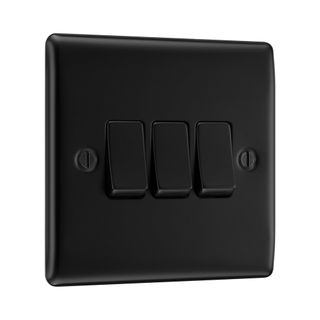
A simple matt black three way switch with matching plate and switches
Planning your lighting circuits
"A good lighting scheme should bring an intangible feeling of flow and calm that makes the interior feel warm and nurturing," says Claire Pendarves, independent lighting consultant at The Soho Lighting Company. "This happens when you dovetail carefully planned circuits and controls to ensure easy manipulation of mood and function."
The easiest way therefore to avoid common lighting design mistakes is by learning the difference between types of light switches and properly planning your lighting circuits from the outset. This will help you avoid issues such as inadequate lighting, difficult-to-reach switches, or overly complicated setups that are frustrating to use - or, at worst, dangerously installed.
Consider your home layout
Consider how you move through each room and the pathways you take around your home. In spaces like hallways or staircases, installing a two-way or intermediate switch at both ends allows you to control the lighting easily, no matter which direction you're heading.
Think about room usage
Different rooms will require different types of lighting. For instance, when lighting a home office, you might benefit from bright, task-oriented lighting with a dimmer switch to reduce glare. On the other hand, a bedroom might require softer, ambient lighting controlled by a simple one-gang switch.
In the reception room pictured below, John Cullen Lighting has installed two distinct types of lighting - an overhead statement light and dimmable recessed lighting - with a two gang switch to control both.


Toggles, rockers, dimmers and touch switches
There are several different styles of light switch to choose from, each with its own aesthetic appeal and practical advantages.
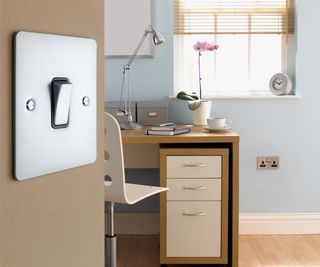
Toggle and rocker switches
Toggle and rocker switches are the most popular types of light switches, but despite their similarities, each style offers a distinct look and a slightly different way of operating. Toggle switches are the more 'classic' option, featuring a small lever that flips up or down to control the lights. They are widely recognised and have been a staple in homes for decades, making them a go-to choice for those who appreciate traditional decor.
Rocker switches, in contrast, have a flat, wider design that rocks back and forth. This gives them a cleaner, modern appearance. One of the key advantages of rocker switches is their ease of use. The broader surface makes them easier to operate, which can be particularly beneficial for people with limited dexterity.
Both options are reliable, easy to install, and widely available in different finishes and designs. However, both styles lack advanced features like dimming or smart capabilities.
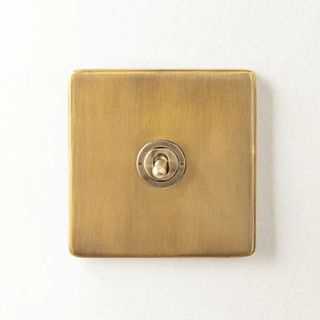
The lustrous, buttery brass of this toggle light switch makes it a perfect addition to a traditional living room or bedroom lighting scheme.
Dimmer switches
Dimmer switches are a popular choice for those looking to create adjustable lighting levels. According to Alex Steele, "there are numerous benefits to using dimmer switches throughout your house. They offer flexibility and control to provide a range of different moods to suit the time of day. They can help reduce glare from lights and also when lights are dimmed, they consume less energy and extend the life of the bulbs."
However, not all light bulbs are compatible with dimmer switches, particularly some types of LED bulbs and fluorescent bulbs. Make sure you select dimmable bulbs when using these switches.
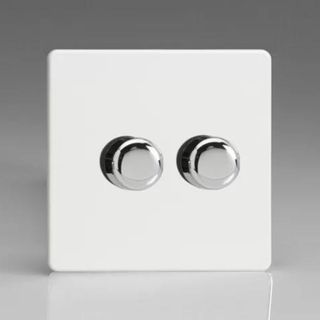
This 2 gang dimmer switch features an adjustable minimum brightness setting and a choice of driving modes.
Touch switches
Touch switches offer a modern, sleeker alternative to traditional light switches. They can be operated with a simple tap rather than a flip or push, and they are perfect for minimalistic interiors.
Unlike traditional flip switches, touch switches may require more careful installation and compatibility checks with your existing electrical system. That being said, they are an excellent choice for tech-savvy homeowners or those looking to add a modern touch to their home decor. They are also compatible with many smart lights (see below).
Smart switches
Smart home tech is gaining popularity thanks to the level of convenience it offers, and smart light switches are no exception. These switches allow you to control your lights remotely via a smartphone app, making it easy to turn lights on or off from practically anywhere. This feature is particularly handy if you, or a member of your family, have limited mobility or you're concerned about home security. Like the best smart bulbs, smart switches can also be integrated into a broader smart home system, such as Amazon Alexa or Google Home.
However, these advanced features come with some drawbacks. Smart switches tend to be more expensive than traditional switches and often require a compatible smart home hub or system, which can add to the overall costs. Installation is also more complex, meaning you'll likely need professional assistance to make sure everything is set up correctly, and you'll want to make sure smart switches are compatible with your home’s Wi-Fi network before installing them.

This Yagusmart light switch can be controlled by voice or mobile app, and it was named Best Smart Switch in our Light Switch Buying Guide.
FAQs
Can you mix dimmer and non-dimmer switches in the same room?
"Yes, dimmers and simple on/off switches can be used in the same room and even the same plate if required," says Alex Steele. "If this is something you are interested in, there are numerous styles to suit your requirements - from rotary dimmers, rockers and dolly switches.
"However, it's important to note that you are unable to use two rotary dimmers for two-way or intermediate switching," he adds. "This does not mean you cannot do achieve multiple switching, but that the second switch can only operate as switch only (on/off). The selection of a momentary dimmer would solve this problem but require more complicated installation and equipment."
Are you ready to start planning your home lighting? Take inspiration from these bedroom lighting ideas and these 10 gorgeous lighting ideas for vaulted ceilings.
Get the Homebuilding & Renovating Newsletter
Bring your dream home to life with expert advice, how to guides and design inspiration. Sign up for our newsletter and get two free tickets to a Homebuilding & Renovating Show near you.

Gabriella is an interiors journalist and has a wealth of experience creating interiors and renovation content. She was Homebuilding & Renovating's former Assistant Editor as well as the former Head of Solved at sister brand Homes & Gardens, where she wrote and edited content addressing key renovation, DIY and interior questions.
She’s spent the past decade crafting copy for interiors publications, award-winning architects, and leading UK homeware brands. She also served as the Content Manager for the ethical homeware brand Nkuku.
Gabriella is a DIY enthusiast and a lover of all things interior design. She has a particular passion for historic buildings and listed properties, and she is currently in the process of renovating a Grade II-listed Victorian coach house in the West Country.
